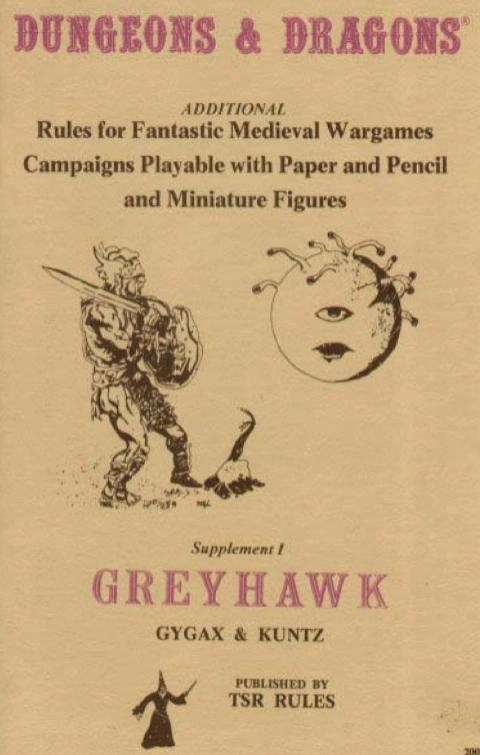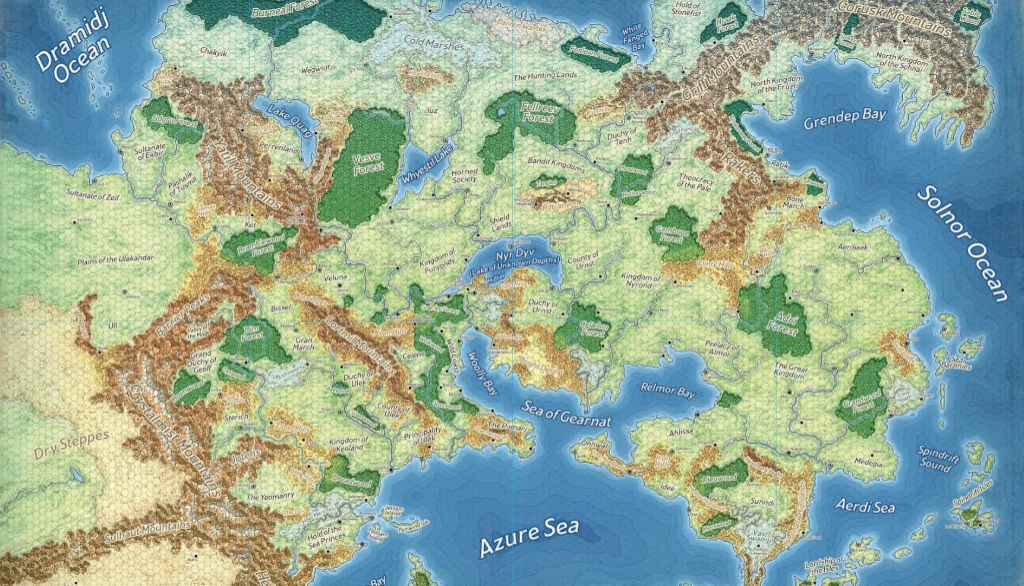When you’re leafing through the pages of the upcoming Dungeon Master’s Guide, set to hit shelves this November as part of D&D 2024. The familiar scent of fresh ink and new possibilities filling the air, you might notice something different. The default setting isn’t the Forgotten Realms in the latest edition. Instead, you’re reading about a world called Greyhawk. For some of you, this name might spark a nostalgic gleam in your eye. For others, it might be a curious first encounter. So what is with the new default setting for DnD 2024? Lets take a journey to the World of Greyhawk, D&D’s original campaign setting, and find out what we’re in for.

Greyhawk: The OG of D&D Worlds
First things first - what exactly is Greyhawk? Well, imagine if Gary Gygax, one of the founding fathers of D&D, decided to create an entire world. Oh wait, he did! That’s Greyhawk in a nutshell. This high fantasy setting centers on the continent of Oerth (yes, that’s Earth with an ‘O’, because why not?), with most of the action taking place in a region called the Flanaess.
Now, I know what some of you are thinking. “But I’ve been playing in the Forgotten Realms for years! Why the change?” Well, my friends, sometimes to move forward, we need to take a step back. And in this case, we’re stepping back to the very roots of D&D.
A Brief History of Greyhawk
Before we dive deeper into what makes Greyhawk tick, let’s take a quick jaunt through its history. Trust me, it’ll help you appreciate just how momentous this return really is.
Greyhawk’s journey began in the early 1970s as Gary Gygax’s personal campaign setting. But it didn’t say his for long - it quickly became a collaborative effort, with many of D&D’s original creators leaving their mark on this burgeoning world.
Take, for instance, David Arneson’s Castle Blackmoor. This mega-dungeon, one of the earliest and most iconic in D&D history, found its home in the north of Greyhawk. Its influence? Monumental. From the sprawling levels of Undermountain in the Forgotten Realms to the demon-infested halls of video games like Diablo, Blackmoor’s DNA is everywhere.
Many of D&D’s most iconic NPCs - names like Bigby and Robilar - started as characters in Gary’s original play group. It was a world built not just by designers, but by players, their adventures weaving the very fabric of the setting. This to me always solidified the idea that collaborative world-building was fundamental to the D&D experience. Shared setting development was part of the bones of the game from the start.
It wasn’t until 1980 that fans like myself got our first real taste of this rich world with the release of the World of Greyhawk folio. For a pre-teen me, it was like discovering that all those disconnected adventures actually existed in a fully-realized world. I gave me that feeling of a deep, living world that captivated me in the fictional settings I loved so much.
The 1983 “Gold Box” set expanded the world even further. Throughout the 80s and early 90s, Greyhawk thrived, with countless adventures, sourcebooks, and articles fleshing out its rich tapestry of cultures and conflicts.
The late 90s and early 2000s saw Greyhawk take a bit of a backseat, but it never truly went away. The “Living Greyhawk” organized play campaign kept the flame alive, allowing players to continue shaping the world’s ongoing narrative. If I recall correctly, this was the origin of what would eventually become the DnD Adventurers League we know today.
And now, after years of teasing references in various 5e products, Greyhawk is poised to reclaim its place at the heart of D&D with the upcoming 2024 edition. It’s a homecoming decades in the making, and for many of us old-timers, it feels like reuniting with an old friend - a friend who’s been shaped by countless hands and imaginations over the years.

A Tapestry of Cultures and Conflict
The core region of Greyhawk was the region of Flanaess. Originally steeped in a strong Eurasian flavor (a product of its time), Greyhawk has since evolved, expanding its cultural horizons beyond its initial borders. Yet, it still carries the DNA of the literary giants that inspired the very foundations of D&D. You can feel the gritty urban landscapes of Fritz Leiber’s Lankhmar, the moral ambiguity of Michael Moorcock’s Eternal Champion saga, the primal energy of Robert E. Howard’s Hyborian Age, and the dying earth vibes of Jack Vance’s work.
At the heart of human civilization are the Oeridians, who once ran the show with their Great Kingdom of Aerdy. Imagine walking the haunted streets of Rauxes, the former capital, now a chilling reminder of how far the mighty can fall. Or picture yourself in the courts of Furyondy, where noble knights plan their next move against the evil forces of Iuz to the north.
But the Oeridians aren’t the only players in this game. To the west, you’ve got the Baklunish cultures in states like Ekbir and Zeif. Think minarets piercing the sky, bazaars bustling with strange wares, and magical traditions that would make your average Oeridian wizard’s pointy hat spin.
And let’s not forget the Suel. These folks have a bit of a checkered past, what with the Scarlet Brotherhood lurking in the shadows. Imagine a secret society of working in the shadows to infiltrate ever aspect of society, with plans spanning the continent. Paranoid yet? You should be.
Then there are the Flan, the original humans of these lands. Their great civilizations might have faded, but their legacy lives on in places like Tenh and among the nomadic Rovers of the Barrens. These are the folks who can tell you what the Flanaess was like before it was cool.
Welcome to the City of Adventure
At the heart of all this stands the Free City of Greyhawk itself. A melting pot of cultures where an Oeridian merchant might be haggling with a Baklunish mage over a Flan artifact, all while a Suel thief picks both their pockets. It’s a city of adventure, intrigue, and more shady deals than you can shake a wand of fireballs at. At the time, it was obvious to me that the City of Greyhawk was the city of Lankhmar from Fritz Leiber’s Fafhrd and the Gray Mouser stories, so I was immediatly hooked.
But humans aren’t the only ones stirring the pot. The Ulek States show us that dwarves, elves, and gnomes have long established cutures of their own. They’re right in the thick of it, forging alliances and shaping the political landscape alongside their human neighbors. This carried much of the tension between cultures that setup a dangerous world in the original days of DnD, which I think ahs softened over time. It will be interesting to see what tension DMs setup in their own versions of Greyhawk.
Why Greyhawk? Why Now?
So, why is Wizards of the Coast bringing Greyhawk back into the spotlight? Well, for one, it’s a return to roots for the 50th anniversary of D&D. Greyhawk is where many of D&D’s iconic elements were born. Ever cast Mordenkainen’s Magnificent Mansion or Bigby’s Hand? You can thank Greyhawk for those. Ever delved into the Tomb of Horrors or faced the horrors of the Temple of Elemental Evil? Greyhawk, baby.
But it’s more than just nostalgia. Greyhawk offers a grittier, more grounded take on high fantasy than the Forgotten Realms. It’s a world where political intrigue is as deadly as any dragon’s breath, where the line between hero and villain is often blurred, and where every victory feels hard-earned. For me, it’s the template for one of my favorite 2e settings, Birthright. At least, this is the original vision of Greyhawk. I think it’s fair to say that WotC has a more portable vision in mind, a Greyhawk that can adapt to any group, any world, and any story. I have to confess, if this is the case, it makes me a little sad. A setting should have a point of view, a flavor that makes it unique. I adore the Forgotten Realms, and I love the homebrew that has sprung from it, but Greyhawk deserves more than a simple “generic fantasy” approach.
WotC has been teasing us with Greyhawk references throughout the 5e era. But now, with part of the recent Vecna: Eve of Ruin module set on Oerth, it seems they’re finally ready to pull back the curtain. I sincerly hope they do it justice when the setting returns to the 2024 Dungeon Master’s Guide in November.
What This Means for You
Whether you’re a grizzled veteran eager to return to familiar lands or a wide-eyed newcomer ready to explore this classic setting for the first time, Greyhawk’s return as the default D&D setting is big news. But what does it really mean for your gaming table?
First off, if you’re hoping to recreate the gritty feel of original Greyhawk, you might find yourself wrestling with the D&D 2024 system. Let’s face it, D&D hasn’t been truly gritty for a long time, and the 2024 edition seems to be dialing up the power level yet another notch. This presents an interesting challenge for DMs: how do you maintain Greyhawk’s classic tone when your players are wielding more power than ever?
On the flip side, the new Bastion system introduced in the 2024 DMG could be a perfect fit for Greyhawk’s political landscape. Players might find themselves quickly rising to become lords of their own realms. Having a rich, detailed setting like Greyhawk to ground these newfound fiefdoms could be incredibly satisfying - provided your players buy into the world’s deep background and complex politics.
It’ll be fascinating to see WotC’s modern take on this classic setting. How will they balance nostalgia with the need to appeal to new players? How dedicated will they be to fully supporting Greyhawk beyond its initial reintroduction? And perhaps most intriguingly, how will the new Greyhawk interact with the evolving Open Gaming License (OGL)? These are questions that could shape not just how we play in Greyhawk, but how we engage with D&D as a whole in the coming years.
For DMs, this means a wealth of opportunities. You’ll have access to a rich, detailed world with decades of lore to draw from. At the same time, you’ll face the challenge of adapting this classic setting to modern game mechanics and player expectations. It’s a chance to blend the best of old-school D&D with the innovations of recent years.
For players, Greyhawk offers a world ripe for exploration and conquest. Whether you’re delving into the depths of Castle Greyhawk, navigating the political intrigues of the Free City, or carving out your own baronies with the Bastion system, there’s no shortage of adventures waiting for you.
Ultimately, the return of Greyhawk is more than just a nostalgic throwback. It’s an opportunity to bridge the gap between D&D’s roots and its future, to explore how a classic setting can evolve to meet the needs of modern players while still retaining its unique charm. Whether this experiment succeeds will depend not just on WotC’s execution, but on how we as a community embrace and shape this new incarnation of a beloved world.
So, are you ready to make your mark on the Flanaess? To walk the streets of the Free City, to face the horrors lurking in Castle Greyhawk, to shape the fate of empires? Greyhawk is calling, adventurers. And this time, it’s calling from the very core of D&D itself. The question is: how will you answer?